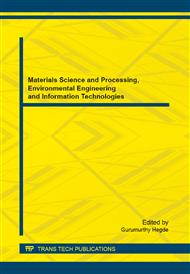[1]
Bergendahl John: Journal of New England Water Environment Association, 38(2004)179-189.
Google Scholar
[2]
Scott Jon P, Ollis David F: Environmental Progress, 14(1995) 88-103.
Google Scholar
[3]
Zhu xiaojun, Lu qin, Zhou gongming et al: China Water & Wastewater, 21(2005)1-3.
Google Scholar
[4]
Chen Buning, etal: Chemical Engineering Journal, 84(2001)77-94.
Google Scholar
[5]
Glaze William H., Kang Joon-Wun: Science and Engineering, 9(1987)335-352.
Google Scholar
[6]
Pohland E. G: AIChE Symposium Series, 71(1975) 308-318.
Google Scholar
[7]
Tjasa G. Bulc: Ecological Engineering, 26(2006)365-374.
Google Scholar
[8]
Yu ruilian, Hu gongren: Environmental Sanitation Engineering, 12(2003)73-75. (in Chinese).
Google Scholar
[9]
Wang fei, Liao li, Wang songlin: Safety and Environmental Engineering, 12(2005)35-40.
Google Scholar
[10]
Deng yansheng, Deng dongfeng: Energy Environmental Protection, 20(2006)30-32.
Google Scholar
[11]
Pirbazari M, et a1: Water Res, 30(1996)2691-2706.
Google Scholar
[12]
Cecillia O man, per-A ke Hynning: Environmental Pollution, 80(1993)265-271.
Google Scholar
[13]
Nancy Ragle, John Kissel: Water Environment Research, 67(1995)238-243.
Google Scholar
[14]
Carley B N, Mavinic D S: Water Research, 63(1991)51-59.
Google Scholar
[15]
Taina H. Hoilijoki, Riitta H. Kettunen: Water Research., 34(2000)1435-1446.
Google Scholar
[16]
Shiskowski D. M, et al: Water Res. 32(1998)2533-2541.
Google Scholar
[17]
Sletten R.S. et al: Water Research, 29(1995)2376-2386.
Google Scholar
[18]
M. Sinan Bilgili, Ahmet Demir: Journal of Hazardous Materials, 24(2006)1-9.
Google Scholar
[19]
Joar Karsten Q ygard, Amund Mage: Water Research, 38(2004)2851-2858.
Google Scholar
[20]
Kesson M A, Nilsson P: Journal of Environmental Engineering, 10(1997)892-900.
Google Scholar
[21]
Robison H D, Barber C: Pollution Control, 81(1982)46-478.
Google Scholar
[22]
G.E. Schrab, K.W. Brown: Water, Air and Soil Pollution, 69(1993)99-112.
Google Scholar
[23]
D. Geenens: Water Science and Technology, 44 (1999)359-36.
Google Scholar
[24]
Sundaravadivel M., Vigneswaran S: Science and Technology, 31(2001)351-409.
Google Scholar


